 Abengoa
Abengoa
Annual Report 2009
- Corporate Social Responsibility Report
- The Environment and Climate Change
- Environmental Performance and Eco-Efficiency
The term eco-efficiency was first coined by the World Business Council for Sustainable Development (WBCSD) in its 1992 publication entitled “Changing Course”, and is based on the concept of creating goods and services while using fewer resources and lowering their impact on the environment.
Along these lines, the Environmental Sustainability Indicator (ESI) system incorporates a set of variables for measuring the eco-efficiency of Abengoa’s activities, related to the life cycle assessment of both the raw materials employed as well as the end products.
The indicators involved in developing eco-efficiency total 22 and encompass the percentage analysis of the following elements: recycled paper, recycled steel, recycled aluminum, recycled zinc, recycled copper, hazardous substances in raw materials, hazardous substances in manufacturing, renewable energy, energy/production consumption, recycled water, water/production consumption, scrap wood purchased, scrap wood utilized, recycled cardboard purchased, recycled cardboard utilized, recycled plastic purchased, recycled plastic utilized, recyclable wood, recyclable cardboard, recyclable plastic, recoverable packaging and biofuel use.
Abengoa strives to boost the eco-efficiency of its activities through life cycle assessment of its products, using accurate indicators that enable improvement target-setting to minimize production impact and enhance the recyclability of the company’s products.
Abengoa’s Main Environmental Indicators
The task of calculating the environmental indicators takes into account Abengoa’s work centers, associated activities, and all projects promoted directly by the company, with the exception of those companies that have yet to implement an environmental management system within the Telvent business group. All other projects take into consideration the main figures deriving from our operations, excluding raw materials, consumption or waste attributable to the promoters of said projects. Likewise excluded are maintenance and operation activities conducted at customer facilities and procurement between Abengoa companies.
To illustrate the wide range of initiatives undertaken, and while not intended to be an exhaustive list, noteworthy is the application in all business units of policies to reduce paper, toner, water and office electricity consumption, in addition to waste collection for subsequent treatment or recycling.
Prime examples of activities geared towards greater control, awareness and minimization of environmental impact include environmental prevention and management, conducted through management systems, dumping and waste inspections, internal and external audits, certification by pertinent authorities, suitable employee training and the use of clean technologies.
In the Industrial Engineering and Construction group, environmental programs are carried out for the work sites, as well as reforestation in areas adjacent to projects under execution and the coordination of subcontracted transportation with the aim of adapting the type of transportation to the size and quantity of the materials to be transported.
Environmental Services takes steps to reduce waste generation, including the sale of certain projects in bulk tanks, in order to prevent the generation of container waste, reutilization and recovery of containers, etc. In order to reduce water consumption, systems for capturing rainwater and raw water supply networks have been built for process water, among other initiatives. In addition to numerous R&D projects, including the development of advanced wastewater treatment and desalination systems, Environmental Services minimizes the potential environmental impact of brine through the study of the brine dissolution and carries out desalination through renewable energies, etc.
The Bioenergy business group conducts activities such as the reuse of water from wastewater and collection of rainwater, among others.
With the aim of improving the reliability of the environmental indicators, improvements have been made to the process of compiling and aggregating data. Some figures from previous years have been rectified according to revised estimation and calculation criteria.
All of the indicators described above have been calculated on the basis of specific protocols for measurement and calculation, with the aim of standardizing application criteria.
Raw Materials
Due to the nature and sheer variety of Abengoa’s activities, it is practically impossible to list each and every one of the raw materials it employs. Available data has therefore been aggregated and consolidated so as to give a real and adjusted picture of our environmental impact.
Agricultural products, including grain, sugar cane, vegetable oil and alcohol surpluses for bioethanol production, are an important group of raw materials utilized in Abengoa’s activities as a whole. Gasoline blended with bioethanol (85% bioethanol and 15% gasoline) is also used to obtain E85 fuel.
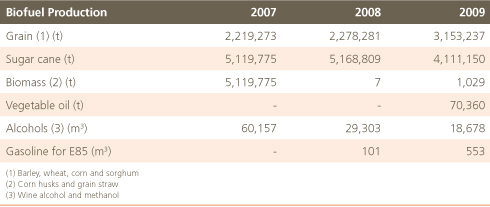
Vegetable oil and gasoline are reported from the year in which consumption began.
A wide range of raw materials is used in the field of industrial construction, although particular importance is attached to metal products. Iron is used mainly in manufacturing metal structures for electrical power transmission lines, and zinc is used in galvanizing these structures.
We have no available data for 2007, having since reclassified our materials.
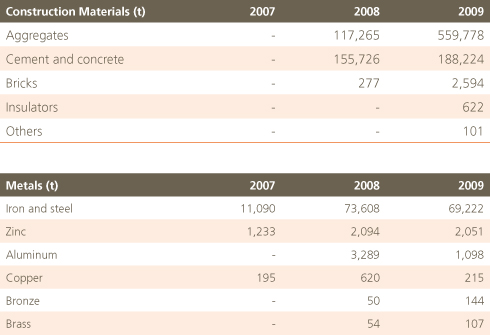
In a group with significant activity in the field of engineering, paper has traditionally been the chosen means of conveying information. In order to reduce paper consumption, different strategies have been approached in recent years: use of recycled paper, printing on both sides of the page and, above all, the extensive use of a corporate network so that all personnel from the different companies spanning more than seventy countries around the world may exchange information.
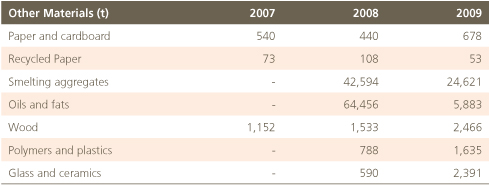
Consumption of recycled paper in comparison to normal paper stood at 8%.
Companies in the Environmental Services area specialize in recycling industrial waste by means of treatment, valorization and recovery, obtaining products such as plastic chippings, secondary aluminum, Waeltz oxide with a 65% zinc content, and secondary zinc. This is the area with the highest potential for recovering products sold, which in practice totals 100% in most cases.
In addition, most consumption of plastic as the raw material is derived from the recycling of the film used in greenhouse enclosures.
The following is a list of the main wastes treated:

This area also encompasses companies dedicated to tank, centrifuge, etc. management, waste treatment and industrial cleaning. Another activity is the management of PCB-contaminated equipment, consisting of the treatment and cleaning of transformers and condensers, both solid and liquid, and the recovery of metals.
The waste in question is listed according to its classification as hazardous or non-hazardous and in terms of the treatment it undergoes.

Livestock waste, including purines, is a further type of raw material we treat.

The following table lists some of the most extensively used chemical substances in the different productive processes. It should be pointed out that the number of substances is wide-ranging, with most involving non-representative quantities.
We have no available data for 2007, having since reclassified our materials.
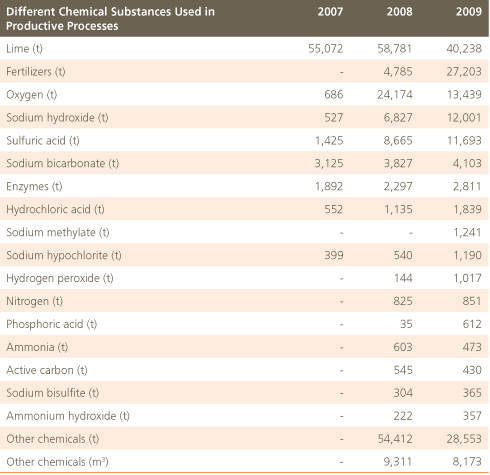
Energy
Data on the amount of electrical power consumed from the grid correspond to permanent work centers, both production sites as well as offices, and to those projects promoted directly by Abengoa.

Data on electrical power consumption in 2007 and 2008 were modified due to an error in calculating units.
By applying this power consumption to the primary sources utilized for generation, in accordance with IEA data for the different countries where Abengoa operates, we can ascertain the following:
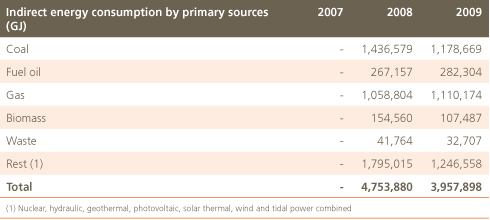
Due to changes in calculation methodology, there is no comparable data available for 2007.
In terms of direct energy consumption, the fuels consumed in the different industrial processes, such as grain dryers, smelting furnaces, machinery, etc., are listed as important elements, as well as in the production of electrical power at cogeneration plants.
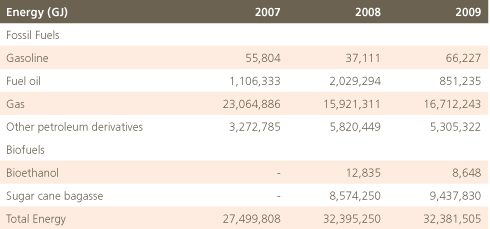
Part of the energy consumed is recovered in the form of electrical power. It should be noted that 6.4% of the production of this energy comes from solar sources.

Water
According to Abengoa’s information system, none of the sources used to collect water features on the Ramsar list of wetlands, or may otherwise be considered especially sensitive, nor is there any record of cases in which annual consumption accounts for more than 5% of the volume of the sources affected.
The company’s policy on sustainability prioritizes reduction at source by minimizing the amount used or reusing water for activities in which potability is not a priority.

The increase in surface water capture over 2009 can be put down to the operation of the desalination plant in Skikda (Algeria), where seawater is captured to generate desalinated water.
Discharges and Spills
Companies that negatively alter the state of the water they utilize due to the nature of their business activities must implement suitable water treatment processes, thereby ensuring that final quality falling within the limits prescribed by applicable law prior to discharge into a public watercourse.
All discharge operations are likewise authorized and controlled by the pertinent authorities.

In the last three years, accidental spills from Abengoa’s activity as recorded through the information channels were irrelevant in terms of magnitude and impact.
Below is a list of spills that occurred in 2009.
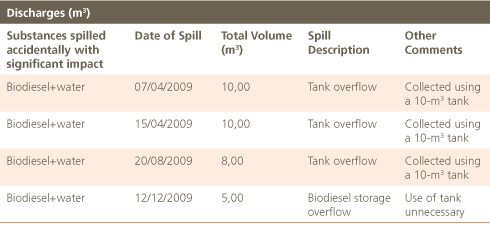
No water resources or habitats affected by the company’s activity were identified through Abengoa’s information system.
Waste
In its normal course of business, Abengoa generates many different types of waste, most of which are monitored through the different environmental management systems implemented in each company. The following table depicts the most significant based on volume.
The waste treated by the Environmental Services business group included in the section on raw materials above is not included here.

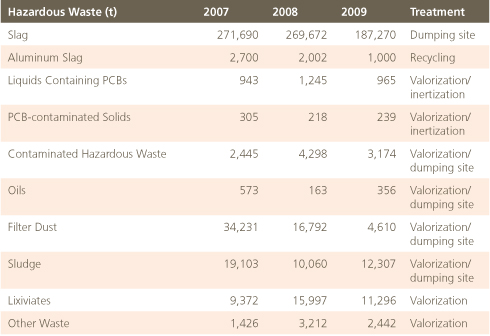
Data from 2008 was updated according to the new interpretation criteria established under the protocol.
In accordance with our Environmental Management Policy, all companies that generate hazardous waste conduct an exhaustive process to identify and monitor these types of waste and their quantities in all operations involving transportation to the authorized waste managers, whether they belong to Abengoa or to outside companies.
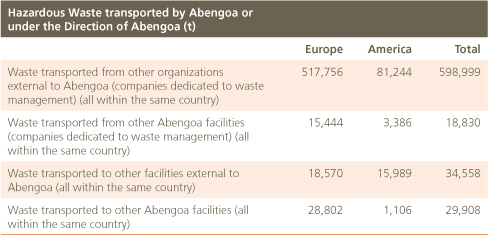
There are also companies which, due to the nature of the equipment they produce (electrical and electronic), adhere to integrated waste recovery systems in order to ensure proper recovery and valorization of their equipment at the end of its useful life. Telvent GIT has an agreement in effect with the ECOTIC Foundation on behalf of Telvent Traffic and Transportation and Telvent Energy and Telvent Environment.